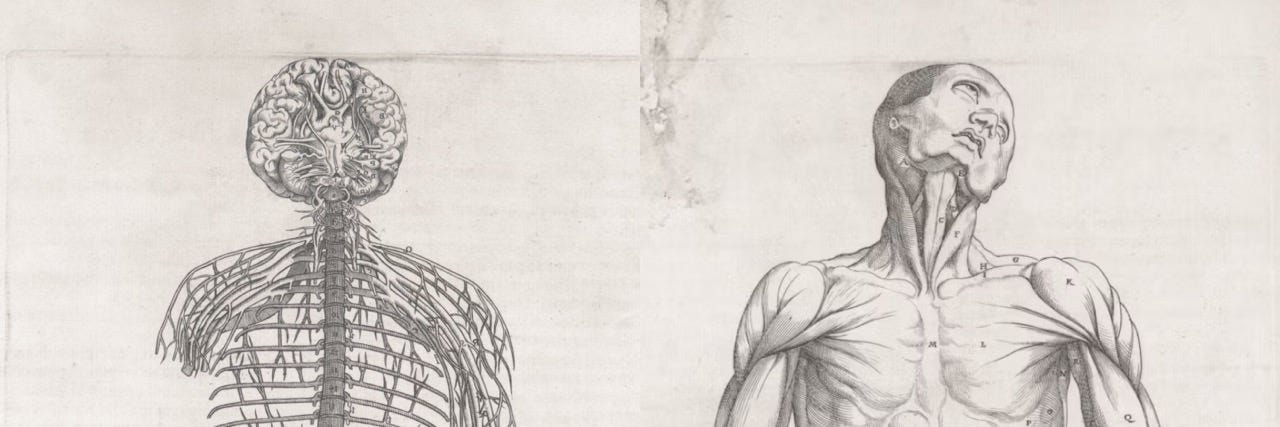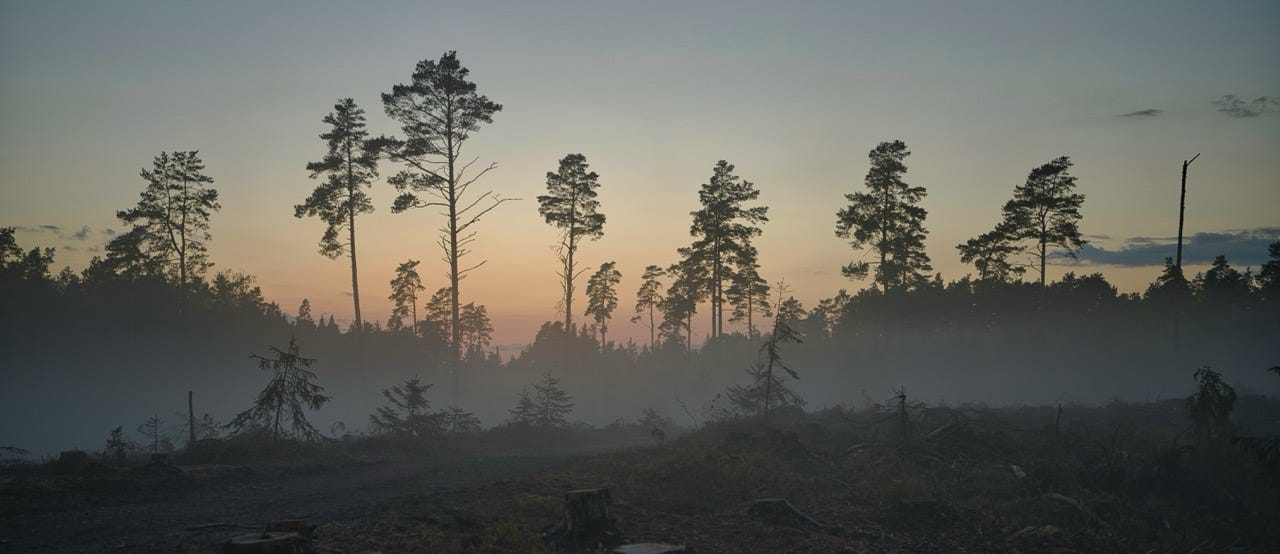Capitalism, Climate Change & Nervous System Regulation
How mastering our nervous systems is the missing link between inner regeneration and outer systems change
I remember the deep feeling of coming home to myself as if I had somehow been away on a long hiatus. Dropping into my body, feeling my breath, noticing emotions, thoughts and sensations—it all felt new. The deeper I tuned into this state of awareness the more I realized how integral this work of interoception—becoming aware of the world within—is central to the work of changing the world around us.
I closed my eyes and realized how much of my struggle had arisen as a result of working in the mind to solve problems outside of me that were actually emanating from deep within. A series of thoughts dawned on me like flashes of lightning in the night sky, creating ripples throughout every layer of my psyche. It was like looking into an infinite mirror and suddenly glimpsing the self-similar sacred geometry of this entire existence:
What if capitalism isn’t just destroying the world around us—but also the world within?
What if the process of burnout is actually an internal reflection of our burning planet?
What if the disconnection we feel is not just that we are physically alone in our little concrete boxes but that we have actually forgotten that we are our ancestors, we are the land and we are the web of life?
And what if the key to systems change isn’t just in policy or protest—but in the way we breathe, in the way we relate, and in the way we regulate our nervous systems to find safety amidst the chaos?
In this essay we’ll dive into the surprising correlation between capitalism, climate change and nervous system mastery—the one skill we all need to thrive yet is not taught anywhere in mainstream society.
The True Cost of Capitalism’s Extraction
Capitalism doesn’t just strip the Earth of her forests, minerals, and waters.
It extracts from the world inside of us too: our attention, our emotions, our sense of time.
We are not just witnesses to the polycrisis—we are participants in it, down to our biochemistry.
The extractive economic system is built on cortisol and adrenaline—scarcity, speed, competition. This neurochemical cocktail is like a prison: It constricts our pupils, closes our heart and clenches our fists.
We caffeinate our mornings, hustle through our days, doomscroll through our nights. We operate as if our worth is tied to our productivity, grind through life as if rest were a threat to our very being.
But at what cost?
Our nervous systems—delicate, ancient technologies wired for rhythm, safety, and connection—are in a constant state of emergency.
Burning out from this place isn’t a personal failure. It’s a systemic signal of imbalance and disease.
It’s our body’s way of saying: this way of living is totally incompatible with life.
“The root crisis of our time is a crisis of belonging. It comes from the atrophy of our ecological and community relationships”
— Charles Eisenstein in TO BE AT HOME IN THE WORLD
We don’t belong here
When I grew up I remember having a persistent lingering feeling in my stomach that something was wrong with this world and that I frankly didn’t belong. I didn’t feel safe in many environments, many times the people around me seemed as if they were acting in some kind of play.
Through sports, education and family dynamics I learned how to swallow my emotions and put on a good face—to do what it took to perform, to score goals, get good grades and be praised by others.
But the cost of this inner repression was immense. It built up over the years and began to take a huge toll on my mental and my emotional health. I began living through a constant tingling of anxiety in my chest. I tried a bunch of different methods to address these underlying issues, but it seemed like I couldn’t really access the root. It was like pulling up a bunch of weeds only to found that there were rhizomes deep beneath that sprouted with a fury every time they were plucked.
It was only during my sabbatical did I stumble upon Jonny Miller’s work at Nervous System Mastery. He had created a five-week program for high-achievers to learn how to take care of their nervous systems—something that no school or workplace seems to teach any of us, but happens to be a vital skill for functioning in the digital age of climate change and global instability.
I remember in the opening module, Jonny shares his moving personal story of losing his fiancé to suicide as a result of an underlying mental health condition. He expressed his belief that at the root of every mental health crisis is a disregulated nervous system. It is now his mission to help people reconnect with themselves, to find that place of deep inner safety within and to resource ourselves to take action and show up to help create a more beautiful world.
The Nervous System as a Bridge to Belonging
Reflecting back on the program over a year later, I realize the human nervous system is actually the connective tissue between our body, mind, and heart.
It is the internal mycelium network that allows us to experience life, feel love, and move toward meaningful action.
When it’s overwhelmed—by too much noise, by speed, or by trauma—we fragment.
We disconnect from our breath, our bodies, and our intuition.
We lose our place in the wider web of life.
But when it’s supported—through rest, nature, rhythm, and co-regulation—we return.
We reconnect. We remember who we are.
We are not machines. We are not separate.
We are ecosystems. We are nature.
This is where taking care of our nervous system and taking care of nature become one symbiotic pursuit…
As the Institute of Natural Law so poignantly said in one of their recent articles:
“When you truly get to know a part of nature, [you] are hardwired to love it. And that feeling of love leads to a deep desire to protect, care for, and restore it… Because how can you love something that you allow to be damaged? You can’t. I know I can’t abide it in my soul, to see my river being damaged.”
— Institute of Natural Law, “Taking an Oath for Nature with Paul Powesland”
Nervous system mastery is not just a form of self-care—it is an act of ecological attunement. It is an invitation to reweave ourselves into the sacred web of life and to find ourselves a place of belonging alongside all our human and more-than-human kin.
The Polyvagal Map: Understanding Our Inner Climate
As a brief primer on the theory, according to Dr. Stephen Porges’ Polyvagal Theory¹, the autonomic nervous system operates in two key branches. Understanding these branches from an internal somatic experience is a fundamental skill for navigating the challenges of our time.
Sympathetic (fight-or-flight): mobilizes us to act under stress. Fueled by adrenaline and cortisol, it’s necessary for survival—but toxic in chronic states.
Parasympathetic (rest-and-digest): governs restoration and connection. Its ventral vagus nerve branch enables presence, creativity, and empathy through oxytocin and serotonin.
The modern capitalist system keeps us locked in sympathetic overdrive: caffeinated, overstimulated, hyperproductive. In this state, love and creativity feel dangerous or indulgent.
Instead of the love hormone oxytocin, we chase dopamine hits through screen time and social status. But dopamine without safety leads to addiction, not connection.
Nervous system mastery invites us to restore balance—to re-access the neurochemicals of trust, bonding, and compassion.
Nervous System Mastery: Practices for Regeneration
True, lasting regeneration begins with how we breathe, how we move, and how we relate.
Here are some science-backed ways to shift your internal state whether you’re in a state of stress, overwhelm, or frozen disconnection. If you resonate with these, I highly recommend checking out Jonny’s course, buying the book Anchored by Deb Dana, or checking out this amazing reading list on nervous systems, emotional intelligence and resilience.
Downregulate (exit stress states)
When we are operating in a state of fight or flight, it’s crucial we have the right tools to downregulate our nervous systems into a place of safety and connectedness. The research shows there are a number of techniques we can use easily to shift
Diaphragmatic breathing with longer exhales (4 counts in, 6 counts out)²
Cold exposure (e.g. ice bath, river dip, cold shower)³
Gentle movement: yoga, walking, dancing
Nature immersion: reduces cortisol within 20 minutes⁴
Limit digital input: create stillness to re-attune attention
Practice NSDR (non-sleep deep rest): Lay down, listen to a track like this for 15-20 mins and enjoy
By creating habit routines attuned to the cycles of nature, we can program these short behaviors into our daily life and develop a baseline of a regulated, rested and resourced nervous system.
Upregulate (restore vitality and connection)
Similarly, when we become emotionally frozen and disconnected from ourselves and our environment, it’s actually vital to mobilize our nervous systems and take action in order to shift into a connected state.
Co-regulation: presence with others who feel safe
Breathwork: Try a succession of short exhalations through your nose, pumping rhythmically with your diaphragm
Sunlight and physical movement to energize dopamine pathways
Oxytocin practices: hugs, eye contact, singing, gifting a coffee to a stranger
Creative expression: paint, dance, write—without pressure
These practices don’t just make you feel better. They rewire your nervous system to become more resilient, more present, and more human. Being able to notice what state your nervous system is in and shift into a state of connectedness is a key feature of being able to adapt to the constant changes in the world around us.
Johnny’s got a new app called State Shift to support people with exactly this process through gamification.
A Fractal Model for Regeneration
In nature, the micro mirrors the macro.
River deltas resemble our veins. Neural networks mimic forest roots.
A single raindrop reflects the ocean.
This is the holonic pattern of reality: each being is a whole in itself, and simultaneously part of a greater whole.
Your nervous system—regulated, relational, embodied—is not a private affair.
It’s a node in the global system.
Your healing is Earth’s healing. When you heal the earth, you heal yourself.
We cannot regenerate the world while living in extraction ourselves.
We are not separate from the biosphere
The climate crisis is not only ecological—it is emotional, somatic, and relational.
When we restore nervous system safety, we become capable of restoring the Earth.
We can become composters of trauma. Midwives of new systems. Architects of care.
So take a breath.
Feel your feet.
Unplug. Look inside.
You are the revolution.
Footnotes / Sources
Porges, Stephen W. The Polyvagal Theory: Neurophysiological Foundations of Emotions, Attachment, Communication, and Self-Regulation (2011)
Brown, R.P., & Gerbarg, P.L. (2005). Sudarshan Kriya Yogic breathing in the treatment of stress, anxiety, and depression: Part I—Neurophysiologic model.
Kox, M. et al. (2014). The effects of the Wim Hof Method on the autonomic nervous system and immune response.
Hunter, M.R., Gillespie, B.W., & Chen, S.Y.P. (2019). Urban nature experiences reduce stress in the context of daily life based on salivary cortisol.
Photos
Human body sketches by The New York Public Library on Unsplash
Forest photo by Maksim Shutov on Unsplash
Cactus photo by Sebastián Brito on Unsplash
Inspiration
This post was inspired by a post from Institute of Natural Law on Instagram, drawing the correlation between capitalism, climate change and the human nervous system.






